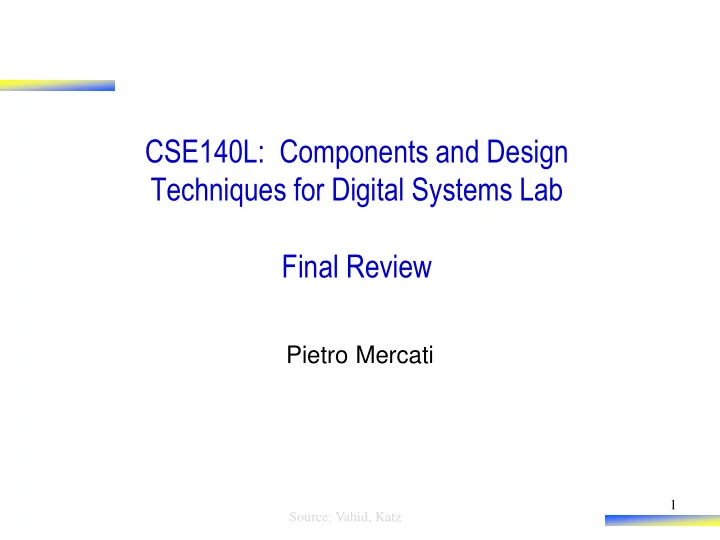

CSE140L: Components and Design Techniques for Digital Systems Lab Final Review Pietro Mercati 1 Source: Vahid, Katz
Example of True/False questions • Everybody should submit his/her CAPE evaluation because that is an extremely important feedback for the university and for instructors to improve the quality of teaching T 2
Example of True/False questions 1) Verilog is a HDL T 2) The LHS of a procedural assignment should always be a reg T 3) Verilog is used to describe a behavior that is synthesized into real hardware T 4) A reg variable is a register F 5) Dynamic power consumption does not depend on operating voltage F 6) The TinyCPU lab homework was an example of combinational circuit F 7) Mixing blocking and non-blocking assignment in the same procedure is highly recommended F 8) Wire and reg are data types in Verilog T 9) $display is a keyword that automatically synthesize a display for your digital circuit F 10) Xylinx is a major FPGA vendor T 11) An FPGA is a type of HDMI adapter F 12) If “ `timescale 1s/1ms ”, then #100 is a delay of 100ms F 3
Examples of Multiple Choice Questions 1) A FSM with 6 states requires at least: a) 2-bit states b) 3-bit states c) 4-bit states d) None of the above 2) The value of a displayed by the following code at time 30 is #20 a <= 10; #5 a <= 20; a) 10 b) 20 c) 5 d) None of the above 4
Examples of Multiple Choice Questions 3) The value of a displayed by the following code at time 30 is #20 a = 10; #5 a = 20; a) 10 b) 20 c) 5 d) None of the above 5
Examples of Multiple Choice Questions 4) What’s the keyword in Verilog testbenches to indicate that interrupts the simulation with the possibility of resuming it? a. $finish b. $monitor c. $stop d. $fish e. None of the above 5) Compared to the carry-lookahead adder, the ripple-carry adder is: a. Slower b. Faster c. Smaller d. Bigger e. a & c f. a & d g. b & c h. b & d 6
Example: code analysis Which mistakes are contained in the following code? Module my_multiplier(a, out, in); 1) out is missing from port input [3:0] a; declaration (it should be an input clk; input port) output in; 2) clk should be in the port list reg in; 3) reg in should be reg [3:0] in 4) endmodule is missing always@(negedge clk) begin 5) This design needs a reset if (out == 1) in <= a; else in <= in+1; end 7
Example: from code to circuit module my_circuit(a, b, in1, wire4); input a,b, wire4; output in1; reg in1; wire out3; reg out98; a out98 always begin b in1 out98 <= a & b; in1 <= out98 | out3; wire4 end assign out3 = a ^ wire4; a out3 endmodule 8
Example: from state diagram to code module my_fsm(C, clk, reset, out); input C, clk, reset; output out; reg out; reg [1:0] state; C=0 reg [1:0] next_state; parameter S0 = 2’b00; S2: p arameter S1 = 2’b01; S0 if (in == 0) p arameter S2 = 2’b10; next_state = S1; 1 else C=1 always @(posedge clk) begin next_state = S2; if (reset) endcase state = S0; end else C=0 state = next_state; S1 end always@(state) 0 Always@(C or state) begin C=0 case(state) case(state) S0: out = 1; S0: S1: out = 0; if (in == 0) S2: out = 0; next_state = S0; endcase else end S2 next_state = S1; C=1 endmodule 0 S1: if (in == 0) next_state = S0; else next_state = S2; C=1 9
CAPE Please submit your CAPE evaluations! 10
Summary of CSE140L – SU216 • Transistors and circuit delays • Basics of Verilog: operators, syntax • Quartus IDE + Modelsim simulation (HW1) • Implementation of Verilog modules (HW2) • Implementation of testbenches (HW2,3,5) • Re-using modules to implement larger modules (instantiation + explicit module connection) (HW3,4) • Implementation of a large project using smaller modules as building blocks (HW4) • Implementation of Mealy and Moore FSM (HW5) 11
Summary of CSE140L – SU216 • Digital circuits can be described using HDLs and synthesized automatically using IDEs such as Quartus • HDLs are different from programming languages • You can (and actually should) use and re-use components that you already implemented to build larger components 12
Good Luck for the Final Exam! 13
Recommend
More recommend